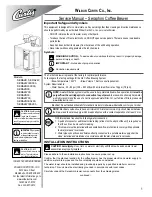
GAMMA instabus
Technical Product Information
August 2013
Binary input device N 262E11
5WG1 262-1EB11
16x potential-free contacts
Siemens AG
N 262E11, 4 pages
Technical Manual
Infrastructure & Cities Sector, Building Technologies
Control Products and Systems
Siemens AG 2013
Update: http://www.siemens.com/gamma
P.O. Box 10 09 53, D-93009 Regensburg
Subject to change without further notice
2.7.4.2/3
EMC requirements
Complies with EN 50090-2-2 and EN 61000-6-2
Environmental conditions
Climatic withstand capability: EN 50090-2-2
Ambient operating temperature: - 5 ... + 45 C
Storage temperature: - 25 ... + 70 C
Rel. humidity (not condensing): 5 % to 93 %
Markings:
KNX EIB
CE mark
In accordance with the EMC guideline (residential and
functional buildings), low voltage guideline
Position and function of the display and
operating elements
Ph ys. Ad r.
L
N
A1
A2
A3
A4
A5
A9
A8
A6
A7
Figure 1: Position of the display and operating elements
A1
Button for toggling between normal mode / ad-
dressing mode for transferring the physical address
A2
LED for displaying normal mode (LED Off) or ad-
dressing mode (LED On); it is automatically extin-
guished once the physical address has been trans-
ferred
A3
Plug for bus connecting terminal
A4
LEDs for status display of inputs a to h
A5
LEDs for status display of inputs A to H
A6
Terminals for inputs a to h
A7
Terminals for inputs A to H
A8
Terminals for L-conductor and neutral conductor (N)
for power supply of the electronics
A9
LED for displaying the operating voltage
Installation and wiring
General description
The DIN rail mounted device in N-system dimensions
(width 6 module units) can be inserted in N-system dis-
tribution boards, surface- or flush-mounted and wher-
ever DIN rails according to EN 60715-TH35-7.5 are pre-
sent. The connection with the bus line is either carried
out via a bus terminal or via the contact system to the
data rail.
Installing the DIN rail mounted device (Figure 2)
-
Suspend the DIN rail mounted device (B 1) on the DIN
rail (B2) and
-
Rotate the DIN rail mounted device (B1) backwards un-
til the slide switch audibly clicks into position.
Dismantling the DIN rail mounted device (Figure 2)
-
Remove all connected cables
-
Press the slide switch (C3) downwards with a screw-
driver and
-
Remove the DIN rail mounted device (C1) from the DIN
rail (C2) with a swivel action.
B1
C2
C3
B2
C1
Figure 2: Installing / dismantling the device
Removing the bus terminal (Figure 3)
-
The bus terminal (D2) is located on the upper side of
the binary input device N 262E11 (D1).
-
The bus terminal (D2) consists of two sections (D2.1,
D2.2) each with four terminal contacts. Care should be
taken not to damage the two test sockets (D2.3) either
by accidentally trying to put in the bus cable or with
the screwdriver (when trying to remove the bus termi-
nal).
-
Carefully insert the screwdriver into the wire entry slot
underneath the bus terminal (D2) and pull the bus
terminal (D2) forwards out of the binary input device
(D1).
Note:
Care should be taken as there is a risk of shorting the bus
pins with the screwdriver!






















